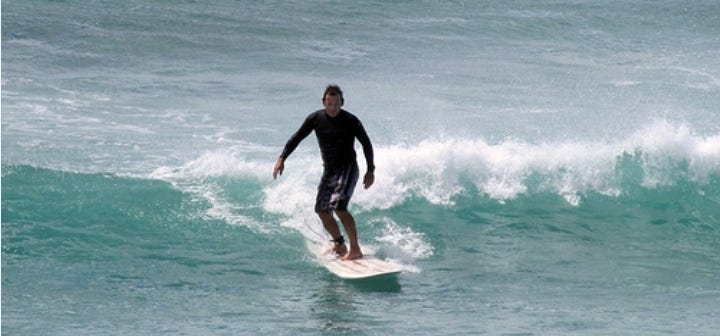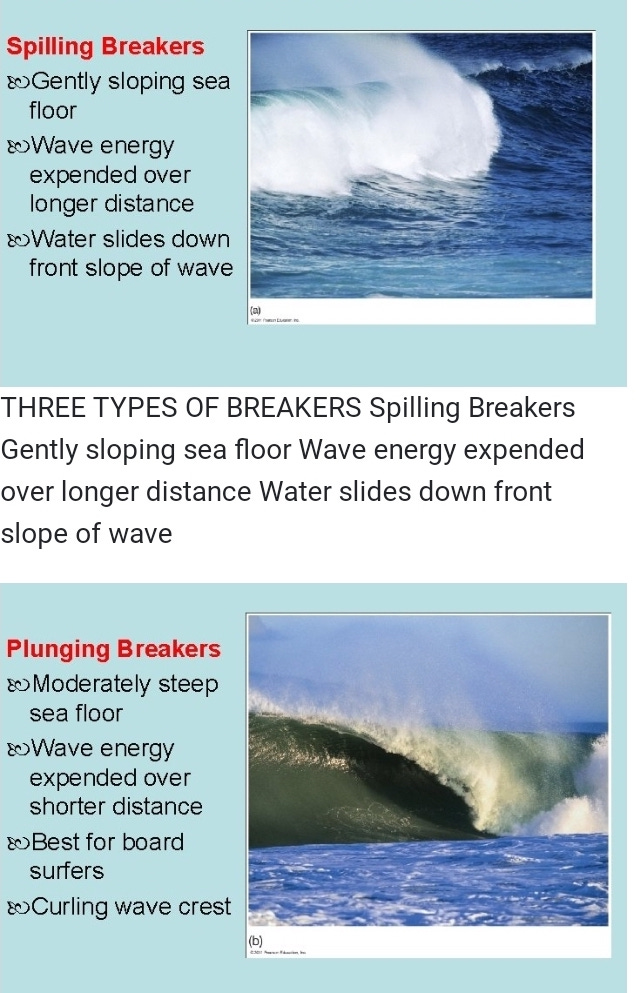Learning to Surf in Non-beginner Waves
The guys who’ve taken me with them like to joke that I’ll be the first person to ever learn to surf at Peñitas!
Having spent the past few months and a dozen or so outings at 4 different beaches in pretty big waves, I think I’ve learned some good pointers to help anyone who is going to get out amongst them and be safe, have fun, and maybe even learn to surf.

SURFING IS SWIMMING
On your first day out, you want to stay focused on the fundamental and perhaps surprising truth, that surfing is swimming. Every time out you’ll spend 99% of your time in the waves swimming, even if you’re standing on your board swishing around, too. You want to learn what being out with your board entails.
Your board is a floatation device!
For the most part this is uber-helpful. For sure, this is what helps you swim around for a couple hours. For sure, if you catch a wave and stand up, this is indeed the ostensible goal! But swimming through breaking waves to get in position to try to catch a ride is the strenuous part of surfing, and it must be done over and over as you attempt to ride in with a wave, and then turn around and go back out to try again — and your floatation device makes this challenging, since the waves want to always take the board in.
That said, my friend Marcos gave me a good gut-check reminder, which is that it is possible that your leash could fail, your floaty would be lost to you, and you want to be sure that your swimming ability should be strong enough to get you back to shore without it.
The guys set me up with a long 9’ styrofoam board to learn on. They are able to duck-dive under incoming breaking waves with their fiberglass boards, but with the big styrofoam board, you’re not able to push it underwater and follow. You need to learn to turtle-roll through foamy spilling waves, and if the waves are plunging (curling over), you’ll need to bail off your board altogether, swim down as the wave passes over, and then use your leash to recover your board and regroup to keep swimming out.
The well-executed turtle-roll keeps you with your board in good alignment heading out. You tip over sideways with your board upside-down, now on top (“floating”) at the surface in the foam of the wave and you underneath, and then use the momentum of rolling to try to get back on top! You get pushed back towards shore, but ideally, you can gain some “ground” going back out before the next breaker comes in. REPEAT until you get out past the last breaker.
Surf-able waves come in “sets” of handfuls of big waves, and then lulls to get back out, and ideally, rest. If you’ve tried to catch the first wave of the set, you’ll be closer to shore where the rest of the set is now going to keep breaking right on top of you. I’ve seen good surfers with fiberglass boards, retreat to the shore and wait for the lull, rather than try to duck-dive under every incoming big breaker. But with a floaty styrofoam board, the bail-off and swim down technique, is a helpful way to reduce your struggle and conserve energy while you repeat treading water and grabbing your board until the lull when you can climb back on and try to swim out quickly.
PS — swimming on your board is VERY tough on your ribs. Just like developing callouses for certain sports on hands and feet, and developing a tough “saddle” under your butt for riding a bike, it takes constant use to toughen and keep your ribs tough. Your first time out will hurt during and after.
WAITING FOR THE SET
If you’ve succeeded to get out past the incoming breakers — congratulations! I’ve seen strong surfers struggle and end up coming back to shore to rest and look for a better entry point and better timing to get out. Surf reels rarely show the true work of surfing, which is swimming out. It’s an accomplishment.
On your first day surfing, when you get out you’ll be further from shore then you’re probably used to being. This is a challenging realization that might not provide calming vibes after the adrenaline and exertion of swimming out. But if you sit up on your board and focus on your breathing and allow yourself to take in the beauty of the ocean, sky, birds, shoreline, and maybe a nearby sea turtle, it sinks in that your floaty board is an awesome companion, and surfing is something different than shooting curls. It’s a spiritual experience of connecting with a big cosmos with the ocean as your medium.
I like to take my good ol’ time acclimating — breathing, feeling the rollers come in under me, soak in nature, and watch the other guys starting to move here and there positioning themselves and taking a few rides. After I’m feeling calm and adjusted to the conditions, I let myself settle into the next adrenaline rush of intending to try to catch the first wave of the day.
WAVE SELECTION
For the first ten times out, I stayed out past the break where it was safe, and then waited for the waves that would break near that position. What I learned with some coaxing from Illayh, was that this pattern meant that I was trying for the biggest waves every time! Not the best idea for a beginner.
So now, with the confidence I’ve gained by learning the bail-off technique, I try to position closer to shore where smaller waves will likely break to try to catch, and then keep wary to either swim out when the big set comes, or bail-off and swim under them until the smaller wave finds me.
I didn’t learn the bail-off technique without some hard lessons that I hope to help you avoid! Laura told me the technique after I’d already tried to swim over a plunging wave like superman, only to be taken over the waterfall backwards and suplexed upside-down and unceremoniously had my shirt put up over my head, too, at a previous outing. “Over the waterfall” is surfer lingo for going over the curl of the wave and getting dumped into the trough. (I also froze another time sitting on my board when I should have bailed-off, and went over the waterfall sitting.) It’s counter-intuitive to let go of your floatie in big waves, so I urge you beginners to do it purposefully your very first time in the water to give yourself the experiential validation you need to be ready to do it when the big wave comes for you.
COMING BACK IN TO SHORE
When you’re ready for a rest or call it a day, you have to come back to shore, which in big waves, is its own project. If you’re lucky, you might catch a wave and surf one most of the way in, or I usually see the guys do long boogie-board style rides in on their tummies. With your styrofoam board, you can even pop-up on the foamy waves coming in.
I’ve made the mistake of thinking that the foamy waves that come closer to shore can’t wipe you out. While much smaller than the big waves further out, it’s good to stay way back off your board when they blob toward you so that they don’t take you end over end (done that!). Often, there’s a sort of “bog-down” zone where the foamy waves die out, and the waves rebound off the shore, that you have to paddle through. Then the waves can curl pretty hard again right at the shore, so you don’t want to be on top of your board at the beach, or you could get slammed onto your board and the shore simultaneously — yes, did that! And your board can break. So get off your board, try to get plopped on your feet, and run up the beach quick in case the next wave wants to knock you over.
CATCHING A WAVE
I’m putting the “surfing” part last here, because if you’re out in big waves for the first time, every thing I’ve said so far is a lot to take in and practice when you’re live in the water with all that variable movement to assess and respond to. To catch a wave and stand on your board your first time out isn’t a necessary, or even appropriate goal. You want to be safe, and you want to feel safe or you won’t be having an optimal experience.
There’s so much that happens in such a compressed time frame when you try to catch a wave, there’s no substitute for sheer repetition before starting to really work on specific pointers but that first time out, here’s three guidelines that should help.
In big waves you’ll wipeout head over heals easily if you start for waves “early” (which really means that you’re positioned swimming for the wave when it starts curling over before it gets to you). It’s hard to see behind you on your tummy, so waiting longer to start allows you to watch for what the wave is actually doing. But it’s harder to get into position and get going because you’re not super-skilled at maneuvering on your board yet. I think Laura has a sensible approach here, and when I watch her, it always looks like she’s sneaking over from the back of the wave, instead of paddling madly with the wave coming up from behind her. Do your best.
In big waves you’ll wipeout head over heals easily if you’re too far forward on your board. Since you’re not super-skilled at maneuvering on your board yet, over compensate by staying back. You can feel the back of your board with your feet more accurately than gauging what you see in front of you. . . Do your best.
The guys got me to spend time in the area where the waves had already broken and were rolling in all foamy. The entry is messy in the foam, but it’s possible to get more frequent practice popping up without having to wait for the right not-so-big wave further out. And not get so wiped out!
BEGINNER GEAR
A long, styrofoam board
Leash
A tight-fitting shirt
Sunscreen
If you love the beach because of playing in the waves, get ready for a deeper, more immersive experience ;-) I’m 54 years old, and I’ve never been much for swimming. The opportunity to swim with a board has really been amazing. I’ve written separately of how surfing has enriched my life overall here in Mexico.
If you try out the approach I’ve outlined here, you’ll avoid some stress and wasted energy in the water. Being out in big waves is exhilarating enough without making it any harder than it needs to be!


